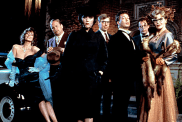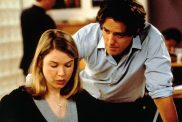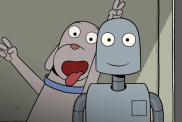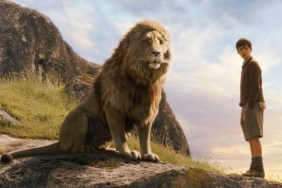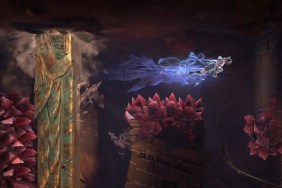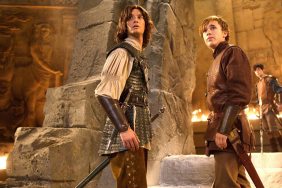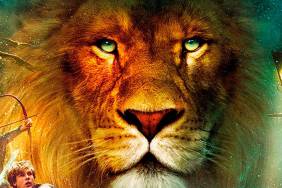Cast:
Georgie Henley as Lucy Pevensie
Skandar Keynes as Edmund Pevensie
William Moseley as Peter Pevensie
Anna Popplewell as Susan Pevensie
Ben Barnes as Prince Caspian
Sergio Castellitto as King Miraz
Peter Dinklage as Trumpkin
Warwick Davis as Nikabrik
Vincent Grass as Doctor Cornelius
Pierfrancesco Favino as General Glozelle
Damián Alcázar as Lord Sopespian
Eddie Izzard as the voice of Reepicheep
Liam Neeson as the voice of Aslan
Review:
The first facts of life explained about Narnia is the passage of time. A day in our world can equal several weeks there, a year several centuries, a fact the Pevensie children quickly discover when, for the second time in their lives, they find themselves whisked back to that magic land in the opening minutes of “Prince Caspian,” the second of C.S. Lewis’s Narnia stories.
And that’s a real problem with “Prince Caspian.” Now that a lot of the cumbersome job of setting up the world and its rules has been done, returning director Andrew Adamson is impatient to jump into the thick of things and while that can be the great strength of sequels, it is just as often their great weakness as well. Characterization and setup, so labored over during the introduction, are left behind in a wake of new elements ideas, often not as well explained or explored.
Having, in their memories, grown to adulthood as great kings and queens, the Pevensies (Georgie Henley, Skandar Keynes, William Moseley and Anna Popplewell) at the end of “The Lion, The Witch and The Wardrobe” found themselves reduced back to children of no special importance, forced to grow up all over again.
The original stories, being fairy tales for children as much as anything else, could get away with that sort of thing without bothering too much how it affected the characters involved, who were gracious to generally accept whatever came along unless a particular story point demanded otherwise. The film versions, which counter intuitively build their fantasy worlds by imitating reality as much as possible, don’t have that luxury. The Pevensie’s of “Prince Caspian” are fundamentally different people than they were before, as you would expect, and are having trouble readjusting. Susan has become standoffish with her peers and Peter has become short-tempered and hot headed, provoking fights often.
It’s a marvelous and interesting ground, a wonderful extrapolation of the characters’ lives and how they’ve changed and a fantastic inner conflict to weave into the story of “Prince Caspian” which itself deals with civil war and conflicts of personality. And it’s no sooner introduced than it is, not dropped entirely, but quietly shuffled off into a corner and a curtain hung in front of it. No sooner are the characters and their inner dilemma introduced than they suddenly find themselves back in Narnia. At first it seems like their problems are solved, they’ve come back home, but they quickly discover that there’s something rotten in Denmark, er, Narnia, and no matter how you slice it, you really can’t go home again.
But it’s all so rushed. Nothing else the main characters do is as interesting as their introduction, and it’s completely passed on by Adamson, who seems to view it as a chore that has to be done so that he can get to the ‘good stuff,’ daring rescues and giant battle scenes, as fast as possible. Before the audience can even breath, much less take in all the new information that’s been sent their way, the Pevensies have rescued a captive dwarf (Peter Dinklage) from being drowned by conquistadors and learned of the conquest of Narnia and the power struggle going on between the titular Prince Caspian (Ben Barnes) and his power hungry uncle, while they try to learn their new place in this new world.
And a new character means that much more screen time taken away from the main characters in a film that is already somewhat shortened, and is made shorter still by the frequent battle scenes. Adamson seems to have decided the great battle at the end of the previous film was its best part and has set out to recapture it but more so, leading to some truly outstanding set pieces, but resulting in a film that is less than the sum of its parts.
That said, it’s not bad by any stretch of the imagination. Adamson has cast the film exceptionally well and that helps a great deal, with strong performances adding a layer of seeming depth to shallow characterization. Peter Dinklage turns in another strong performance as the Pevensies’ guide and friend Trumpkin, taking over admirably from Ray Winstone’s Mr. Beaver with a great deal of rumbled charm that never goes over the edge into parody or cliché. The real highlight, though, is Eddie Izzard’s Reepicheep, a 100% perfect translation from the book. It helps that the character himself fits Adamson’s animator roots and Izzard’s particular style of delivery to a tee, and he steals every scene he’s in.
Compared to that, though, the children mostly stand around and look sullen or confused or both. There’s a lot of running around action heroism involved, especially for the three oldest who certainly look like they’re all having great fun, and it’s easily understandable how appealing that sort of thing would be for a teen and pre-teen audience. The idea of dressing up in swords and armor and interacting with adults at a peer level must be incredibly empowering. But it’s also a bit of waste. Some obvious thought has been put into how the characters would have grown and changed from their experiences and how those changes interact with the new story Peter butts heads with Caspian over who is in charge and Susan, on the cusp of womanhood… again… finds herself drawn to him but the execution is dropped in favor of more battle sequences. It’s better than other two, as Lucy sets about once again representing faith but in a much less interesting manner and Edmund doesn’t do much at all except follow Peter.
A lot of that is Caspian himself’s fault. Or actually Lewis’s. As the titular character the story is mostly about him and his place in a world not his own, but which he might end up belonging to anyway. But even though it is about him, he’s not the main character, the Pevensies are, because it’s their sequel. There’s a very delicate balancing act going on there that doesn’t always work. Adamson’s solution is to focus on Peter, Caspian and Susan and the villainous Miraz (Sergio Castellitto) and shut out everyone else. He’s largely dealing with an inherited problem, but it’s not the best solution and his desire to stay as close to the books as possible, while laudable, backfires on him here. It might almost have been better if the characters had been completely shallow, then we’d never know what we’re missing and could enjoy the fun. As it is, though, there’s a bitter aftertaste of what could have been behind every sequence.
It’s also a fantastic looking film, even moreso than the first. We’re fast approaching the time when human and digital characters will be able to interact together without anyone being able to tell the difference. While we’re not there yet, “Prince Caspian” is as good an indication of where we’re going. The nighttime invasion of Miraz’s fortress is a great example, working as it does on multiple levels, but coming together seamlessly. It’s a fantastic bit of work that nothing else in the film quite matches. Weta Digital and Framestore CFC have outdone themselves. The filmmakers must have thought so too, because there’s even bigger sequences right after it. They’re generally quite good, but the sheer number of them is a little exhausting, especially towards the end. Despite being a good half an hour shorter then “The Lion, The Witch and The Wardrobe,” it feels a good bit longer.
It’s also a good bit darker, with many people killed in the many battle scenes and a deepening of the series’ inherit symbolism. That’s always been a tricky part of the Narnia books and it’s going to get trickier. The core story of “Prince Caspian” is a particular minefield indigenous peoples throwing off a foreign invader through the strength of their faith.
There’s still a lot to like about “Prince Caspian.” The world is suitably rich and well thought out, and some excellent casting choices. It’s villain a bit on the stereotypical side, a problem all the Narnia stories have after the first, a point brought home by the White Witch’s brief appearance in the film, which is more interesting than an entire movie full of Miraz. For Lewis’s purposes it may have been fine that Aslan have no equal, but it hurts the film versions quite a bit.
For all its problems, though, “Prince Caspian” has enough solid strengths to be worth your time, young or old.

